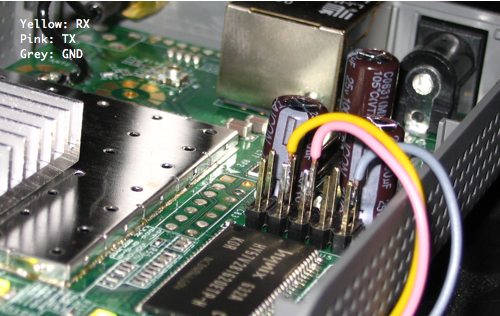Fonera via com:
Allora questo tutorial cerca di spiegare come realizzare un interfaccia per comunicare con la fonera e poi il modo con cui flashare la fonera via com.
Iniziamo:
La costruzione del circuito è relativamente semplice lo schema da seguire è questo:

Io lo ho realizzato con una breadboard così non ho avuto problemi di saldature di nessun genere. i componenti necessari sono:
- Circuito integrato max232
- Connettore RS232(com) femmina 9 pin
- 4 condensatori elettrolitici 1µF
- 1 condensatore elettrolitico 10µF
- Breadboard
Una volta costruito il circuito il max 232 deve essere alimentanto con una corrente stabilizzata a 5v, per fare questo io ho usato un caricatore per nokia che si connetteva all'usb ma qualunque metodo va bene purchè la corrente sia 5v e costante.
K ora come connettiamo l'rx e il tx del max 232? detto fatto:

Come si vede dalla foto (i colori sono errati):
- giallo tx
- rosa rx
- verde massa
Ora per poter passare il fw alla fonera dobbiamo scaricare il fw originale da sito di fon e poi estrarre da questo 2 file cioè: rootfs.squashfs kernel.lzma come facciamo ad estrarli? Da una linux box creiamo un file sh eseguibile fatto così:
SIZE=$(du -b $1 | cut -f1) tail -c $((SIZE-519)) $1 > $1.tar.gz
e diamogli come parametro il fw scaricato dal sito di fon.
Lo script ci creerà un file tar da cui noi dovremmo estrarre i file precedentemente menzionati.
oppure se siamo davvero pigri li ho estratti io per voi e sono scaricabili a questi indirizzi:
Ora per passare i file alla fonera abbiamo bisogno di un tftp server io ho usato quello di winagents ( http://www.tftp-server.com ) ma qualunque voi usiate va bene.. Ora buttiamo nella root del nostro tftp-server i 2 file e abbiamo concluso la configurazione del tftp server.
Ora siamo pronti basta aprire hyper terminal e impostare la connessione sulla com (nel mio caso com1) e poi: bit per secondo: 9600 bit di dati: 8 parità: nessuno bit di stop: 1 controllo di flusso: nessuno
Connettiamoci con hyper terminal e ora accendiamo la fonera. Appena vediamo comparire
Executing boot script in 1.000 seconds - enter ^C to abort
diamo ctrl-c e avremo la shell di red boot.
Diamo i seguenti comandi:
ip_address - l ip.della.fon.era/24 -h ip.adress.del.tftpserver
load -r -v -b 0x80040450 rootfs.squashfs
fis create -b 0x80040450 -f 0xA8030000 -l 0x00700000 -e 0x00000000 rootfs
load -r -b %{FREEMEMLO} kernel.lzma
fis create -r 0x80041000 -e 0x80041000 vmlinux.bin.l7
fis load -l vmlinux.bin.l7
resetK ora se tutto è andato a buon fine al riavvio avremmo una fonera perfettamente funzionante col fw originale di fon.
Ringraziamenti:
La community di ninux poichè mi hanno spinto a tentare di costruire il circuito
Nbd, Heini e billbong per le dritte su redboot e su come cavolo creare le partizioni in modo corretto.
Written by Raffaele








